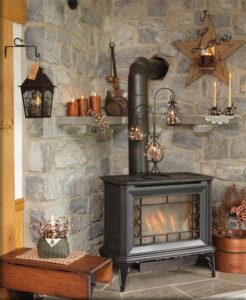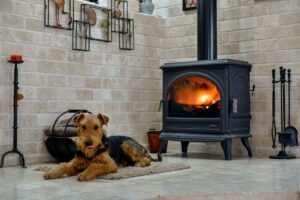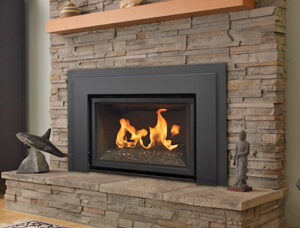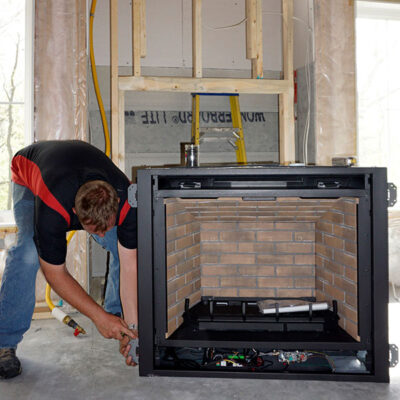Are you considering installing a gas fireplace in your home but wondering if you need a chimney? Look no further. In this article, we will explore the answer to this common question do you need a chimney for a gas fireplace, and provide some tips for choosing and installing a gas fireplace in your home.
In most cases, you do not need a chimney for a gas fireplace. Unlike wood-burning fireplaces, which produce smoke and other byproducts that must be vented through a chimney, gas fireplaces burn clean and do not produce any significant amount of smoke or other pollutants.
Instead, gas fireplaces are typically vented directly to the outside through a wall or roof using a vent pipe. This allows you to enjoy the warmth and ambiance of a fireplace without the need for a chimney.
What is a chimney?

A chimney is a vertical structure that is typically attached to a building and provides a means for smoke and other byproducts of combustion to be vented from a fireplace or other heating appliance.
The chimney is an important safety feature of a wood-burning fireplace, as it helps to prevent the buildup of dangerous gases inside the home and reduces the risk of fire by providing an outlet for hot embers and sparks.
In addition, the chimney also helps to draw air into the fireplace, providing the necessary oxygen for the fire to burn. Also, to its practical functions, a chimney can also add a decorative element to a building’s exterior.
Do you need a chimney for a gas fireplace?
When it comes to gas fireplaces, the need for a chimney is largely dependent on the type of gas fireplace you have and how it is vented. Many gas fireplaces are direct-vent, meaning they have sealed combustion units that are vented directly to the outside through a wall or roof using a special vent pipe.
These fireplaces do not require a chimney and can be installed in any room of the house, regardless of whether there is a chimney present. Other gas fireplaces, such as vent-free or unvented gas fireplaces, do not require a chimney or any type of ventilation.
However, these types of fireplaces are not allowed in all areas, and their use is restricted by building codes and regulations.
Furthermore, it is not necessary to have a chimney for a gas fireplace. However, it is important to consult with a professional and follow local building codes and regulations when choosing and installing a gas fireplace in your home. This will help ensure the safety and proper functioning of your fireplace.
Can a gas fire be fitted without a chimney?
Yes, a gas fire can be fitted without a chimney in many cases. Many gas fireplaces are direct-vent, meaning they have sealed combustion units that are vented directly to the outside through a wall or roof using a special vent pipe.
These fireplaces do not require a chimney and can be installed in any room of the house, regardless of whether there is a chimney present. Other gas fireplaces, such as vent-free or unvented gas fireplaces, do not require a chimney or any type of ventilation.
However, these types of fireplaces are not allowed in all areas, and their use is restricted by building codes and regulations.
Which is better vented or ventless gas fireplace?

When considering whether to install a vented or ventless gas fireplace, there are several factors to consider. Vented gas fireplaces are more realistic and produce more heat, but they also require a chimney and can be more expensive to install.
Ventless gas fireplaces, on the other hand, are easier and less expensive to install because they don’t require a chimney. However, they are not as efficient at heating a room and can produce moisture and condensation.
One of the key differences between vented and ventless gas fireplaces is how they burn fuel. Vented gas fireplaces burn the fuel completely, producing mostly water vapor and carbon dioxide.
This means that they are more efficient and produce less pollution, but they also require a chimney or other venting system to release the byproducts of combustion. Ventless gas fireplaces, on the other hand, do not burn the fuel completely.
Therefore, they are less efficient and produce more pollution, but they don’t require a chimney or other venting system. Another important difference between vented and ventless gas fireplaces is their safety. Vented gas fireplaces are generally considered to be safer because the byproducts of combustion are released outside the home.
This means that they are less likely to produce carbon monoxide or other dangerous gases. Ventless gas fireplaces, on the other hand, release the byproducts of combustion into the home. This means that they are more likely to produce carbon monoxide or other dangerous gases, which can be harmful to people and pets.
Ultimately, the choice between a vented and ventless gas fireplace will depend on your individual needs and preferences. Vented gas fireplaces are more realistic and efficient, but they require a chimney and can be more expensive to install.
Furthermore, ventless gas fireplaces are easier and less expensive to install, but they are not as efficient and can produce moisture and condensation. It’s important to weigh the pros and cons carefully before making a decision.
What happens if you don’t vent a gas fireplace?
If you don’t vent a gas fireplace, the byproducts of combustion will be released into the home. This can be dangerous because gas fireplaces produce carbon monoxide, a colorless and odorless gas that can be lethal if inhaled in large quantities.
Ventless gas fireplaces are equipped with safety features to prevent the build-up of carbon monoxide, but they still produce small amounts of gas.
In addition to the risk of carbon monoxide poisoning, failing to vent a gas fireplace can also lead to other problems. For example, unvented gas fireplaces can produce moisture and condensation, which can damage the fireplace and surrounding walls. They can also produce soot and other pollutants, which can affect the air quality in your home.
Overall, it is important to always vent a gas fireplace properly to ensure the safety of your home and family. If you are unsure how to properly vent your gas fireplace, it is best to consult with a professional who can provide guidance and advice.
Do gas fireplace chimneys need to be cleaned?
Yes, gas fireplace chimneys should be cleaned on a regular basis to prevent the build-up of soot and other pollutants. Over time, the byproducts of combustion from your gas fireplace can accumulate in the chimney, leading to a dangerous situation.
In some cases, a build-up of soot and other pollutants can lead to a chimney fire, which can be very dangerous.
The frequency with which you need to clean your gas fireplace chimney will depend on several factors, including the amount of use and the type of fuel you burn. In general, it is recommended to have your chimney cleaned at least once a year or more often if you use your gas fireplace frequently.
If you are unsure how to clean your gas fireplace chimney, it is best to consult with a professional chimney sweep who can provide guidance and advice. A professional chimney sweep will have the tools and experience to safely and effectively clean your chimney, ensuring that it is in good working order and safe to use.

How can you vent a fireplace without a chimney?
If your fireplace does not have a chimney, there are several options for venting the fireplace. One option is to install a direct-vent fireplace, which uses a special venting system that goes through an exterior wall.
This type of fireplace draws in outside air for combustion and vents the byproducts of combustion outside, so it does not require a traditional chimney.
Another option is to install a ventless fireplace, which does not require any venting at all. Ventless fireplaces burn fuel efficiently and release the byproducts of combustion into the room. This means that they are easy to install and do not require a chimney or other venting system.
However, ventless fireplaces are not as efficient as vented fireplaces and can produce moisture and condensation. They are also more likely to produce carbon monoxide or other dangerous gases, which can be harmful to people and pets.
Overall, the best option for venting a fireplace without a chimney will depend on your individual needs and preferences. It is important to consider the pros and cons of each option and consult with a professional before making a decision.
Pros and cons of vented gas fireplace
Pros of vented gas fireplaces:
- More realistic flame and appearance
- More heat is produced, making them better for heating a room
- More efficient, burning fuel completely and producing mostly water vapor and carbon dioxide
- Safer, as the byproducts of combustion are released outside the home
Cons of vented gas fireplaces:
- Require a chimney or other venting system
- More expensive to install
With the pros and cons above, vented gas fireplaces are more realistic and efficient than ventless gas fireplaces, but they require a chimney and can be more expensive to install.
They are also safer because the byproducts of combustion are released outside the home rather than inside. However, the need for a chimney or other venting system can be a disadvantage for some homeowners.
Recommended:
Safety tips on how to operate gas fireplace
Staying safe around gas fireplaces is important to prevent accidents and injuries. By following safety guidelines and taking the proper precautions, you can help ensure that your gas fireplace is used safely and properly.
Here are some safety tips for operating a gas fireplace:
1. Always follow the manufacturer’s instructions when using your gas fireplace. This will ensure that you are using the fireplace correctly and safely.
2. Make sure the gas valve is in the off position before lighting the fireplace. This will prevent gas from accumulating in the fireplace and creating a potential hazard.
3. Use a long-reach lighter or match to light the fireplace. This will keep your face and hands away from the flame and reduce the risk of burns.
4. Never use flammable liquids, such as gasoline, to start a fire in your gas fireplace. This can be extremely dangerous and can lead to a fire or explosion.
5. Keep flammable materials, such as curtains or furniture, at least three feet away from the fireplace. This will reduce the risk of them catching fire from the flame.
6. Always keep the glass doors of your gas fireplace closed when the fireplace is in use. This will prevent sparks or embers from escaping and starting a fire.
7. Has your gas fireplace been inspected and serviced by a professional on a regular basis? This will ensure that it is in good working order and operating safely.
By following these safety tips, you can help prevent accidents and ensure that your gas fireplace is used safely and properly.
Conclusion
While a chimney is not strictly required for a ventless gas fireplace, it is still important to vent the fireplace properly to ensure the safety of your home and family. Ventless gas fireplaces can produce moisture and condensation, which can damage the fireplace and surrounding walls.
They can also produce carbon monoxide and other dangerous gases, which can be harmful to people and pets. However, this post on do you need a chimney for a gas fireplace gives all that you need to know on whether you should use it or not.

